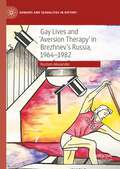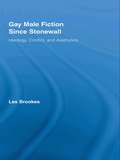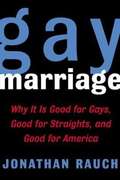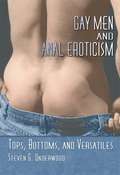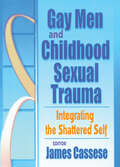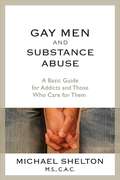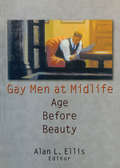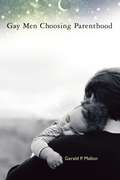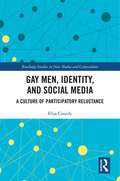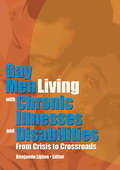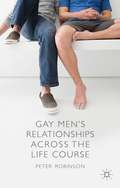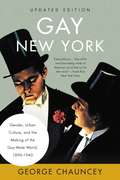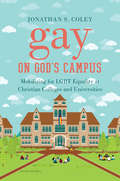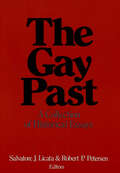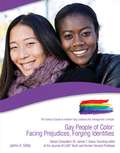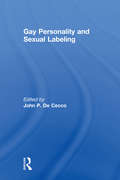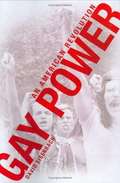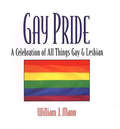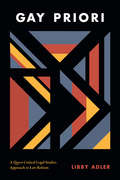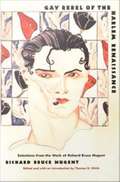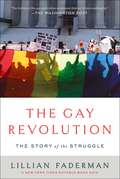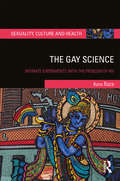- Table View
- List View
Gay Lives and 'Aversion Therapy' in Brezhnev's Russia, 1964-1982 (Genders and Sexualities in History)
by Rustam AlexanderThis book examines the autobiographies and diaries of Soviet homosexual men who underwent psychotherapy during the period from 1970 to 1980 under the guidance of Yan Goland, a psychiatrist-sexopathologist from Gorky. The examination of these unique and little known documents contributes to our scant knowledge about the practices that many would call a Soviet proto-type of 'aversion therapy'. It also helps us understand the way homosexual people faced "queer dilemmas" of the self and how they sought to reconcile their queer desire with being Soviet.
Gay Male Fiction Since Stonewall: Ideology, Conflict, and Aesthetics (Routledge Studies in Twentieth-Century Literature #Vol. 8)
by Les BrookesThe conflict between assimilationism and radicalism that has riven gay culture since Stonewall became highly visible in the 1990s with the emergence and challenge of queer theory and politics. The conflict predates Stonewall, however—indeed, Jonathan Dollimore describes it as "one of the most fundamental antagonisms within sexual dissidence over the past century." By focusing on fiction by Edmund White, Andrew Holleran, David Leavitt, Michael Cunningham, Alan Hollinghurst, Dennis Cooper, Adam Mars-Jones and others, Brookes argues that gay fiction is torn between assimilative and radical impulses. He posits the existence of two distinct strands of gay fiction, but also aims to show the conflict as an internal one, a struggle in which opposing impulses are at work within individual texts. This book places post-Stonewall gay fiction in context by linking it to theoretical and historical developments since the late nineteenth century, and tracing the conflict back to the fiction of Wilde, Forster, Genet, Vidal, Burroughs and Isherwood. Other relevant topics discussed include gay fiction of the 1970s; gays and the family; sexual transgression; gay fiction and the AIDS epidemic.
Gay Marriage: Why It Is Good For Gays, Good For Straights, And Good For America
by Jonathan RauchA leading Washington journalist argues that gay marriage is the best way to preserve and protect society's most essential institution <P><P> Two people meet and fall in love. They get married, they become upstanding members of their community, they care for each other when one falls ill, they grow old together. What's wrong with this picture? Nothing, says Jonathan Rauch, and that's the point. If the two people are of the same sex, why should this chain of events be any less desirable? Marriage is more than a bond between individuals; it also links them to the community at large. Excluding some people from the prospect of marriage not only is harmful to them, but is also corrosive of the institution itself. <P> The controversy over gay marriage has reached a critical point in American political life as liberals and conservatives have begun to mobilize around this issue, pro and con. But no one has come forward with a compelling, comprehensive, and readable case for gay marriage-until now. Jonathan Rauch, one of our most original and incisive social commentators, has written a clear and honest manifesto explaining why gay marriage is important-even crucial-to the health of marriage in America today. Rauch grounds his argument in commonsense, mainstream values and confronting the social conservatives on their own turf. Gay marriage, he shows, is a "win-win-win" for strengthening the bonds that tie us together and for remaining true to our national heritage of fairness and humaneness toward all.
Gay Men and Anal Eroticism: Tops, Bottoms, and Versatiles
by Steven G. UnderwoodGay men reveal their preference-and the reasons behind it! Gay Men and Anal Eroticism: Tops, Bottoms, and Versatiles is a no-holds-barred examination of one of society's most persistent taboos. In a remarkably candid collection of frank and forthright interviews, 21 gay men talk about the role anal sex plays in their lives and relationships and their choices to act as insertive ("top") or receptive ("bottom") partners-or both ("versatile"). Ranging in age from 21 to 65, the men discuss the reasons behind (and consequences of) their choices; how they define their sexual roles (and how those roles are defined by gay society); issues of power, trust, and vulnerability; and the concept (in both straight and gay society) that tops and bottoms are socially and morally unequal. These unique interviews, conducted by the author in the Boston and Provincetown areas, celebrate choice in gay men's sexuality while debating whether preference is genetically based or socially formed-a debate largely ignored in social science studies. The men interviewed-including gay porn icon Cole Tucker-discuss perceptions muddied by stereotypes, preconceived notions, and exaggerated scenarios, and the meanings gay men assign to anal sex, including dominance and submission roles related to masculine/feminine, aggressive/passive implications. The interviews also cover each subject's personal history as a gay man, safe sex in the AIDS era, childhood traumas, first-time sexual encounters, loves, desires, and obsessions. The interviews for Gay Men and Anal Eroticism provide insights that are equal parts thoughtful and outrageous, humorous and heartbreaking: Aaron, age 24: "I sort of fell into this image of myself as being a very aggressive bottom, a guy who knew what he wanted and who didn't want any wimps applying." Danny, 21: "There&’s a mindset about being a top ... it's kinda like maintaining the ship." Sam, 36: "I hate to say it, but I&’m a bottom ... I don&’t like to be identified like that because I feel it turns me into something all the way from my feet up to my head." Eddie, 42: "I guess I enjoy more being a top than a bottom because I haven't found a good top." and Cole Tucker: "A physical act doesn't really make you a top or a bottom. It's a function, an organic function of what you do. It's the dynamics of where you come from."The revealing disclosures of Gay Men and Anal Eroticism show equality in man-to-man sex to be as varied as the number of individuals who pursue it. Addressing traditional misunderstandings and misconceptions of gay men as either "limp-wrested fairies" or masculine "trade," the book uncovers that there is much more to this complex issue than personal preference.
Gay Men and Childhood Sexual Trauma: Integrating the Shattered Self
by James CasseseLearn powerful techniques for healing the scars of early sexual abuse in gay men!The first book of its kind, Gay Men and Childhood Sexual Trauma: Integrating the Shattered Self addresses the specific therapeutic needs of gay men in recovery. All too often, gay men hide their childhood memories of being sexually victimized, because of fear, shame, and the stigma of stereotypes which equate homosexuality with child abuse. Some gay men may view these histories as “rites of passage” and dismiss other perspectives as betrayals of their community or inadvertant support for the anti-gay agenda of the religious right. Certain therapists and so-called support groups ridicule them as hysterics with false memories. Groups like the North American Man-Boy Love Association or the Rene Guyon Society dismiss the source of their anguish as wishful thinking or a healthy, consensual intergenerational romance. Finally here is a book that addresses the unique emotional and psychological needs of gay male survivors of sexual abuse.Gay Men and Childhood Sexual Trauma offers new hope by separating the crime of pedophilia from the consensual intimacy of an adult male same-sex relationship. It provides specific guidance for therapists working with gay men either in individual or group therapy settings, and offers practical treatment suggestions as well as moving insights into the painful conflicts gay men may have in accepting their own sexuality and revealing their status as child survivor of an adult sexual predator. Gay Men and Childhood Sexual Trauma discusses practical ways to help the survivor heal, including: adopting eye movement desensitization and reprocessing techniques to treat traumatized gay men helping gay men to break the old arousal patterns associated with their abusers handling survivors’formidable issues of trust, addictions, depression, and low self-esteem leading survivor groups of mixed sexual orientation discerning the special meaning of HIV to traumatized gay men respecting cross-cultural differences in treating the gay male sexual trauma survivor finding new directions for research This powerful volume offers sufficient technical detail to be useful for the therapist working with gay men, yet it is written with enough clarity and compassion to be used as bibliotherapy for men just coming out as gay, as survivor, or as both. Gay Men and Childhood Sexual Trauma is an essential resource for mental health professionals, as well as for gay men who have themselves survived sexual abuse or who love someone who did.
Gay Men and Substance Abuse: A Basic Guide for Addicts and Those Who Care for Them
by Michael SheltonA timely reference that addresses the unique issues of gay men in recovery.Winner of the 2012 Independent Book Publishers Association Benjamin Franklin Award -- GLBT Category! Gay Men and Substance Abuse fills a tremendous void, serving as a valuable resource for gay men, professionals, concerned partners, friends, and family members in need of solid information and guidance.Whether faced with a traumatic coming out process, caught up in personal struggles with body image, engulfed in the club culture, or navigating a family system that does not accept his sexuality, a gay man struggling with substance abuse or addiction often faces cultural and personal challenges unique to his life experiences. Yet many men and their loved ones in search of help are forced to adjust to a traditional treatment system, or self-help groups that center on heterosexual relationships, and family groups that neglect to include partners or address what can be a uniquely challenging family dynamic.By exploring the social and psychological factors that play into homosexual men's addictions, nationally certified treatment counselor Michael Shelton presents a timely, comprehensive look at best practices in meeting the unique needs of gay men in recovery, offering keen insight on a range of issues, including:such common therapeutic approaches as motivational enhancement therapy and 12 Step strategiessuccessful relapse prevention protocolstools for recovery from co-occurring sexual disordersthe importance of a loved one's role with regard to intervention and supportthe complicated relationship between gay male drug use and sexual behaviorhow to talk knowledgeably, and with care and sensitivityAbout the author Michael Shelton, M.S., C.A.C., is a nationally certified treatment counselor and does clinical work with males with substance abuse and sexual disorders at four facilities in Philadelphia. He's the author of four other books, including Boy Crazy: Why Monogamy Is So Hard for Gay Men and What You Can Do About It.
Gay Men at Midlife: Age Before Beauty
by John Dececco, Phd Alan L Ellis“Those of us in our forties and fifties came of age in the 1960s and 1970s--a time when the available commentary on gay life was anything but supportive. Until 1973, homosexuality was a diagnosable mental illness.” --from the Introduction by Alan L. EllisToday, that literary blindness is being remedied. Take an in-depth look into the lives of 15 gay men and how they relate to their own aging with Gay Men at Midlife: Age Before Beauty, a fascinating new book that explores and clarifies the issues that confront gay men as they age. What happens to gay men's lives when they reach middle age?The essays in Gay Men at Midlife: Age Before Beauty offer a realistic picture of both the challenges and the joys that present themselves in the lives of gay men at midlife. The book does not gloss over the difficulties of the experience; you will truly come to understand that each gay man is not alone in confronting the pain and mourning that may accompany middle age.The people who frankly, openly, and intelligently discuss their personal lives in Gay Men at Midlife: Age Before Beauty include: psychotherapist/popular columnist Tom Moon (San Francisco, California) professor of philosophy and literature Alejandro Medina-Bermudez (Madrid, Spain) television executive George Pierson (Bethesda, Maryland) multimedia artist Trevor Southey (born in the country now known as Zimbabwe, currently working in San Francisco) activist/researcher Frank Wong (New York) . . . plus 10 more individuals from varying backgrounds!Gay Men at Midlife: Age Before Beauty provides a look at how these individuals are redefining the stereotypes of aging gay men and empowering themselves to find meaning and purpose in the second half of their lives.
Gay Men Choosing Parenthood
by Gerald MallonGay parenting is a topic on which almost everyone has an opinion but almost nobody has any facts. Here at last is a book based on a thorough review of the literature, as well as interviews with a pioneering group of men who in the 1980s chose to become fathers outside the boundaries of a heterosexual union—through foster care, adoption, and other kinship relationships. This book reveals how very natural and possible gay parenthood can be. What factors influence this decision? How do the experiences of gay dads compare to those of heterosexual men? How effectively do professional services such as support groups serve gay fathers and prospective gay fathers? What elements of the social climate are helpful—and hurtful? Gay Men Choosing Parenthood challenges a great deal of misinformation, showing how gay fathers from different backgrounds adapted, perceived, and constructed their options and their families.
Gay Men Choosing Parenthood
by Gerald P. MallonGay parenting is a topic on which almost everyone has an opinion but almost nobody has any facts. Here at last is a book based on a thorough review of the literature, as well as interviews with a pioneering group of men who in the 1980s chose to become fathers outside the boundaries of a heterosexual union—through foster care, adoption, and other kinship relationships. This book reveals how very natural and possible gay parenthood can be. What factors influence this decision? How do the experiences of gay dads compare to those of heterosexual men? How effectively do professional services such as support groups serve gay fathers and prospective gay fathers? What elements of the social climate are helpful—and hurtful? Gay Men Choosing Parenthood challenges a great deal of misinformation, showing how gay fathers from different backgrounds adapted, perceived, and constructed their options and their families.
Gay Men, Identity and Social Media: A Culture of Participatory Reluctance (Routledge Studies in New Media and Cyberculture)
by Elija CassidyThis book explores how the social and technical integration of mainstream social media into gay men’s digital cultures since the mid 2000s has played out in the lives of young gay men, looking at how these convergences have influenced more recent iterations of gay men’s digital culture. Focusing on platforms such as Gaydar, Facebook, Grindr and Instagram, Cassidy highlights the ways that identity and privacy management issues experienced in this context have helped to generate a culture of participatory reluctance within gay men’s digital environments.
Gay Men Living with Chronic Illnesses and Disabilities: From Crisis to Crossroads
by Benjamin LiptonUnderstand gay men&’s unique health issues beyond the incomplete focus of HIV to include the concerns of those living with a broad range of chronic illnesses and disabilitiesGay Men Living with Chronic Illnesses and Disabilities: From Crisis to Crossroads is the groundbreaking book that comprehensively examines and forms strategies to respond to the needs of gay men living with non-HIV chronic illnesses and disabilities such as diabetes, cancer, obesity, and muscular sclerosis. Bringing together the interdisciplinary expertise and unique perspectives of leaders in the fields of social work, psychology, and rehabilitation counseling, this groundbreaking book helps you understand the key issues from theoretical, clinical, practical, and personal perspectives. Gay Men Living with Chronic Illnesses and Disabilities: From Crisis to Crossroads conceptualizes and addresses the integration of psychosocial and medical issues faced by the gay men living with both HIV-related and non-HIV chronic illnesses and disabilities. Each chapter delves deeply into the psychosocial impact of their marginalization in daily living while offering strategies for partnership and integration between gay and mainstream health and social service organizations. With extensive, up-to-date bibliographies at the end of each chapter and case studies that illuminate theoretical discussions, this book is essential reading for those involved in health policy and practice with gay men living with chronic illnesses and disabilities.Gay Men Living with Chronic Illnesses and Disabilities: From Crisis to Crossroads explores: the "invisibility" of gay men living with non-HIV illnesses and disabilities and the need to provide adequate services to them the impact of sexual orientation on living with a broad range of life-threatening illnesses the multiple layers of stigma of being gay while living with a chronic illness or disability how chronic illness can lead to increased body dissatisfaction in gay men the multidimensional challenge of psychotherapy with HIV positive gay men the connection between aging, chronic illness, and sexual orientation living with a non-HIV chronic illness as a gay social service professionalGay Men Living with Chronic Illnesses and Disabilities: From Crisis to Crossroads is vital reading for social workers, psychologists, psychiatrists, physicians, sociologists, public health advocates and experts, community organizers, and everyone engaged in providing medical, social, or psychological services.
Gay Men's Relationships Across the Life Course
by Peter Robinson Michael KirbyThis book examines the life stories of a diverse sample of gay men from nine major international cities. Through their relationship stories, old established patterns of gay life are compared with new, emerging patterns of fatherhood, friendship and parenting.
Gay New York: Gender, Urban Culture, and the Making of the Gay Male World, 1890-1940
by George ChaunceyGay New York brilliantly shatters the myth that before the 1960s gay life existed only in the closet, where gay men were isolated, invisible, and self-hating. Based on years of research and access to a rich trove of diaries, legal records, and other unpublished documents, this book is a fascinating portrait of a gay world that is not supposed to have existed.
Gay on God's Campus: Mobilizing for LGBT Equality at Christian Colleges and Universities
by Jonathan S. ColeyAlthough the LGBT movement has made rapid gains in the United States, LGBT people continue to face discrimination in faith communities. In this book, sociologist Jonathan S. Coley documents why and how student activists mobilize for greater inclusion at Christian colleges and universities. Drawing on interviews with student activists at a range of Christian institutions of higher learning, Coley shows that students, initially drawn to activism because of their own political, religious, or LGBT identities, are forming direct action groups that transform university policies, educational groups that open up campus dialogue, and solidarity groups that facilitate their members' personal growth. He also shows how these LGBT activists apply their skills and values after graduation in subsequent political campaigns, careers, and family lives, potentially serving as change agents in their faith communities for years to come. Coley's findings shed light on a new frontier of LGBT activism and challenge prevailing wisdom about the characteristics of activists, the purpose of activist groups, and ultimately the nature of activism itself. For more information about this project's research methodology and theoretical grounding, please visit http://jonathancoley.com/book
The Gay Past: A Collection of Historical Essays
by Salvatore Licata Robert P PetersenFascinating reading on the plight of gay men and women through the ages. The contributors to this compassionate book document how society has made life difficult and even dangerous for homosexual people. Through narrative history as well as biography, these essays trace the legal, social, and physical consequences of this oppression.
Gay People of Color: Facing Prejudices, Forging Identities
by Jaime A. SebaWhat does it feel like to be a minority within a minority? For lesbian, gay, bisexual, and transgender (LGBT) people of color, their experiences coming out and living openly can be incredibly complicated. They may face discrimination from their community because of their sexual orientation, and they may be subjected to racism by their LGBT peers. Learn about the complicated health and personal issues related to this community, and find out how role models such as openly gay comedian Wanda Sykes, drag performer RuPaul, Latino icon Ricky Martin, and openly gay actor B.D. Wong help provide representations of LGBT people of color.
Gay People, Sex, and the Media
by Michelle Wolf Alfred KielwasserHere is a provocative book that examines precisely how and why mass communication has an impact upon the sexual realities of our lives. Written in response to a demand for information that cuts across many of the boundaries found in more traditional books on sexuality and mass communication, Gay People, Sex, and the Media covers a broad range of sexual identity, socialization, and mass communication issues and represents a variety of theoretical and methodological orientations. Although the chapters are diverse, they all focus on how the mass media--television, radio, films, newspapers, magazines, and recorded music--contribute significantly to the very definitions we form of ourselves and of each other. In part, this informative volume discusses and analyzes several concerns regarding minority perspectives in the context of the the study of mass media content and effects; analyzes mediated information about AIDS and highlights the responsibility of the mass media to disseminate more accurate information; addresses the relationships between mass media content (primarily television) and sexual socialization; explores issues confronted by individuals whose sexual orientations are generally perceived as falling out of the mainstream; and provides a selective bibliography of print, aural, and visual resources on gay men, lesbians, and the mass media. Unique in contrast to other books of research on human sexuality and mass communication, Gay People, Sex, and the Media gives more than a passing reference to issues concerning sexual identity and gay and lesbian concerns. Scholars and students of human sexuality, especially those who wish to explore their field from a communications perspective, will find this to be a valuable book. It is also useful to communications researchers and teachers, particularly those studying mediated communications in society, media ethics, and sex and the media. Finally, for professionals involved in creating or monitoring media content or forging public policy and community action programs in response to these issues, this volume serves as an essential sourcebook.
Gay Personality And Sexual Labeling: Critical Clinical Issues
by John Dececco, PhdAre scientists--who by definition are supposed to be objective and clinical in their theories--actually assuming common cultural prejudices and moral standards when it comes to their research on homosexuality? Some of the best minds in sexual liberation take a hard look at how homosexuality is still defined and viewed by established schools of thought and propose fascinating and often controversial ideas on the true nature of the gay personality and identity. This challenging book explores how gay people can “label” themselves or avoid the gay label entirely while still being homosexual, as well as how others label gay people.
Gay Power: An American Revolution, 1969-1980
by David EisenbachThe explosion of gay visibility following the street riots at the Stonewall Inn in 1969 brought, for the first time, tens of thousands of lesbians and gay men out of the closets and into headline news around the world. Never before had so many gay people at one moment stepped into the spotlight of mainstream American politics, culture, and entertainment. More than any city, New York became overnight the center of the new "Gay Power" movement and served as the focal point for gay protest and politics for the next decade. Gay Power, chronicles the tumultuous first wave of the modern gay rights movement. From the first-ever gay student group launched at Columbia University in 1965 to the Gay Liberation Front, the Gay Activist Alliance, and other vanguard organizations that emerged from the Stonewall riots, David Eisenbach draws on archival material and numerous firsthand accounts from the individuals who built the movement. Unlike their predecessors, this new generation of lesbians and gay men spoke as a community, established political clout, appeared openly on television and in the press, demanded equal rights with heterosexuals, and pioneered protest tactics like the "zap," which later ACT UP employed famously in the 1980s.
Gay Pride: A Celebration Of All Things Gay And Lesbian
by William J. Mannhe Ancient Greeks--What's there to be proud of about the ancient Greeks? Well, only that they set the groundwork for all of Western Civilization, thought up the concept of democracy, encouraged more original thinking than anyone before or since, and actually celebrated same-sex love.<P> The Castro--For any gay first-time visitor, alighting from the trolley at the famous intersection of Castro and Market in San Francisco is like stepping into Oz. Historian Susan Stryker has called it "the symbolic main street of the city's queer community and an emblem of gay pride around the world." It has become synonymous with liberation, freedom, and celebration, and while today there are many vibrant gay neighborhoods, the Castro retains an enduring place in the hearts of gay men and lesbians everywhere.<P> Alan Turing--The founder of computer science. A brilliant mathematician. Philosopher, wartime codebreaker, visionary--and an unapologetic gay man well ahead of his time.<P> The NEA Four--Tim Miller, John Fleck, Holly Hughes, and Karen Finley--two gay men, a lesbian, and a queer-identified straight woman. No wonder these performance artists were singled out by the National Endowment for the Arts in 1990 and denied artists' grants, causing an international uproar that still has ramifications today.<P> These are just a few of the fabulous reasons for Gay Pride. Read on to find out more about the queer pioneers, past and present, who have made the world a braver, bolder, and better place--for everyone!<P> We're here. We're queer. Get used to it!<P> As if Alexander the Great, the Harlem Renaissance, A Member of the Wedding, and piano bars weren't enough, here are 101 fabulous reasons to celebrate the rich heritage and vast cultural contributions of gays and lesbians. This inspiring, joyous book triumphantly commemorates the many ways gays and lesbians have profoundly shaped the face of the world's politics, art, literature, music, theatre, cinema, sports, civil rights, and much more. From the fighting spirit of the Radical Faeries to the groundbreaking TV comedy of Will and Grace, from Walt Whitman's immortal "Song of Myself" to the incendiary power of Tony Kushner's Angels in America and the searingly candid art of Frida Kahlo, gays and lesbians have made life sweeter, deeper, more humane, and, well, so much more fabulous. Need more reasons to be glad? How about:<P> * Gay places of pride: The Castro, Bloomsbury, Metropolitan Community Church, Berlin.<P> * Literary gays: Gertrude Stein and Alice B. Toklas, Oscar Wilde, James Baldwin, Dorothy Allison.<P> * Gay power brokers: The Sony Building in New York, Freed's Fairies and the MGM musicals, Dykes on Bikes, PFLAG, ACT-UP.<P> * Gay stars: Ian McKellan, Elton John, Rudy Galindo, Martina Navratilova, Ellen DeGeneres, Marlene Dietrich.<P> Whether it's the wicked fun of camp, the powerful impact of queer cinema, or the lazy, summertime pull of Provincetown, Gay Pride is filled with an array of reasons to live proud that is as diverse and beautiful as the gay and lesbian community it celebrates.
Gay Priori: A Queer Critical Legal Studies Approach to Law Reform
by Libby AdlerLibby Adler offers a comprehensive critique of the mainstream LGBT legal agenda in the United States, showing how LGBT equal rights discourse drives legal advocates toward a narrow array of reform objectives that do little to help the lives of the most marginalized members of the LGBT community.
Gay Rebel of The Harlem Renaissance: Selections From the Work of Richard Bruce Nugent
by Richard Bruce NugentRichard Bruce Nugent (1906-1987) was a writer, painter, illustrator, and popular bohemian personality who lived at the center of the Harlem Renaissance. Protégé of Alain Locke, roommate of Wallace Thurman, and friend of Langston Hughes and Zora Neale Hurston, the precocious Nugent stood for many years as the only African-American writer willing to clearly pronounce his homosexuality in print. His contribution to the landmark publication FIRE!!, "Smoke, Lilies and Jade," was unprecedented in its celebration of same-sex desire. A resident of the notorious "Niggeratti Manor," Nugent also appeared on Broadway in Porgy (the 1927 play) and Run, Little Chillun (1933) Thomas H. Wirth, a close friend of Nugent's during the last years of the artist's life, has assembled a selection of Nugent's most important writings, paintings, and drawings--works mostly unpublished or scattered in rare and obscure publications and collected here for the first time. Wirth has written an introduction providing biographical information about Nugent's life and situating his art in relation to the visual and literary currents which influenced him. A foreword by Henry Louis Gates Jr. emphasizes the importance of Nugent for African American history and culture.
The Gay Revolution: The Story of the Struggle
by Lillian Faderman<P>The sweeping story of the modern struggle for gay, lesbian, and trans rights--from the 1950s to the present--based on amazing interviews with politicians, military figures, legal activists, and members of the entire LGBT community who face these challenges every day. <P>The fight for gay, lesbian, and trans civil rights--the years of outrageous injustice, the early battles, the heart-breaking defeats, and the victories beyond the dreams of the gay rights pioneers--is the most important civil rights issue of the present day. Based on rigorous research and more than 150 interviews, The Gay Revolution tells this unfinished story not through dry facts but through dramatic accounts of passionate struggles, with all the sweep, depth, and intricacies only an award-winning activist, scholar, and novelist like Lillian Faderman can evoke. <P>The Gay Revolution begins in the 1950s, when law classified gays and lesbians as criminals, the psychiatric profession saw them as mentally ill, the churches saw them as sinners, and society victimized them with irrational hatred. Against this dark backdrop, a few brave people began to fight back, paving the way for the revolutionary changes of the 1960s and beyond. Faderman discusses the protests in the 1960s; the counter reaction of the 1970s and early eighties; the decimated but united community during the AIDS epidemic; and the current hurdles for the right to marriage equality. <P>In the words of the eyewitnesses who were there through the most critical events, The Gay Revolution paints a nuanced portrait of the LGBT civil rights movement. A defining account, this is the most complete and authoritative book of its kind.
Gay Rights at the Ballot Box
by Amy L. StoneThe passage of the anti-gay marriage Proposition 8 in California in 2008 stunned gay rights activists across the country. Although facing a well-funded campaign in support of the ballot measure, LGBT activists had good reasons for optimism, including the size and strength of their campaign. Since 1974, the LGBT movement has fought 146 anti-gay ballot initiatives sponsored by the religious right and has developed innovative strategies to oppose these measures. In Gay Rights at the Ballot Box, Amy L. Stone examines how the tactics of LGBT activists have evolved and unravels the complex relationship between ballot measure campaigns and the broader goals of the LGBT movement.The first comprehensive history of anti-gay ballot measures, both those merely attempted and those successfully put before voters, this book draws on archival research and interviews with more than one hundred LGBT activists to provide a detailed account of the campaigns to stop such ballot measures from passing into law. As Stone shows through in-depth case studies, although LGBT activists lost the vast majority of these fights, they also won significant statewide victories in Oregon in 1992 and Arizona in 2006, and local successes, including ones in Ypsilanti, Michigan, in 1998 and 2002. Stone analyzes how LGBT activists constantly refined their campaign tactics in response to both victories and defeats. She also stresses that such campaigns have played both a complementary and contradictory role within the LGBT movement. Specific anti-ballot campaigns and the broader movement do often strengthen each other. However, ballot measure campaigns sometimes distract activists from the movement&’s more general goals, and activists at the movement level can pressure local campaigns to take on more than they can handle. With gay rights coming under increasing assault from the religious right, this book is a vital resource for LGBT activists and others working to block their efforts.
The Gay Science: Intimate Experiments with the Problem of HIV (Sexuality, Culture and Health)
by Kane RaceSince the onset of the HIV epidemic, the behaviour of men who have sex with men has been subject to intense scrutiny on the part of the behavioural and sociomedical sciences. What happens when we consider the work of these sciences to be not merely descriptive, but also constitutive of the realities it describes? The Gay Science pays attention to lived experiences of sex, drugs and the scientific practices that make these experiences intelligible. Through a series of empirically and historically detailed case studies, the book examines how new technologies and scientific artifacts – such as antiretroviral therapy, digital hookup apps and research methods – mediate sexual encounters and shape the worlds and self-practices of men who have sex with men. Rather than debunking scientific practices or minimizing their significance, The Gay Science approaches these practices as ways in which we ‘learn to be affected’ by HIV. It explores what knowledge practices best engage us, move us and increase our powers and capacities for action. The book includes an historical analysis of drug use as a significant element in the formation of urban gay cultures; constructivist accounts of the emergence of barebacking and chemsex; a performative response to Pre-Exposure Prophylaxis and its uptake; and, a speculative analysis of ways of thinking and doing sexual community in the digital context. Combining insights from queer theory, process philosophy and science and technology studies to develop an original approach to the analysis of sexuality, drug use, public health and digital practices, this book demonstrates the ontological consequences of different modes of attending to risk and pleasure. It is suitable for those interested in cultural studies, sociology, gender and sexuality studies, digital culture, public health and drug and alcohol studies.
